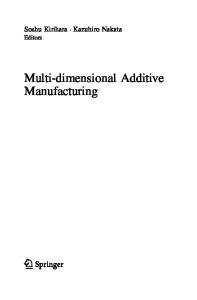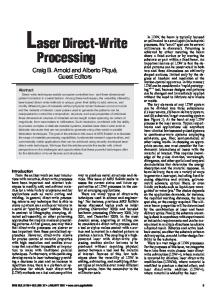Selective Laser Annealing for Device Processing
- PDF / 943,859 Bytes
- 6 Pages / 417.6 x 639 pts Page_size
- 51 Downloads / 372 Views
I.D. CALDER, A.A. NAEM and H.H. Bell-Northern Research, Ottawa,
NAGUIB Canada
KIY 4H7
ABSTRACT Selective laser crystallization of undoped polysilicon films has been achieved through the use of a patterned Si 3 N4 anti-reflection (AR) coating. The recrystallized poly-Si beneath the AR cap exhibits an etch rate 50-90% lower than the surrounding uncapped material, allowing anisotropic etching of poly-Si for the fabrication of MOSFET gates. Undercut is reduced by at least a factor of two from unannealed material. Annealed edge profiles are uniform within± 0.03pm for plasma etching (± 0.05 for wet etching) compared to ± O.ljm (± 0.25um for wet etching) for unannealed regions. The sheet resistivity of 0.5pm films doped by phosphorus diffusion was reduced from an initial value of 82±5 a/0 to 40±8 £/U when the dopant was diffused into recrystallized poly-Si and to a final value of 10.2 ± 0.2 Q/23 after a further laser activation step. Potential applications in VLSIC processing are discussed.
INTRODUCTION Research into cw laser crystallization of polysilicon films has been directed towards the formation of large grain or single crystal silicon films for silicon-on-insulator (SO1) devices [I] or three dimensional integration [2]. The resistivity of heavily doped poly-Si, as used in MOS gates and interconnects, can also be reduced by a factor of two [31, enabling faster devices to be fabricated. When LA is applied to real devices, the variations in optical and thermal properties across complex structures will cause the attainable temperature to be strongly dependent upon the sample structure. In particular, conditions that will melt one region of a structure may not melt another region, as desired, while raising the temperature of a third region to a destructively high value. Our objective in this work has been to characterize a technique for selective laser annealing (SLA) of IC structures [2,4], so that only designated regions of poly-Si are melted and crystallized. We present results on the effects of SLA on the grain morphology, etching characteristics and sheet resistivity of poly-Si films. Some potential applications of this technique in the fabrication of conventional and novel MOS devices are outlined. EXPERIMENTS Figure I illustrates the reflectivity R [5] of solid and liquid Si for Ar laser light as a function of the thickness of a Si 3 N4 antireflection (AR) coating on silicon. These calculations take into account the spectral content of Ar laser light and the dependence of the optical constants on wavelength and temperature [6,7]. They indicate that since we intend to melt the silicon, the
selected thickness of the Si 3N4 AR film should be - 53nm, i.e.
intermediate
between the optimum values for solid and liquid Si. In practice, we use a Si 3 N4 thickness of 60 ± 5nm to improve the uniformity and the quality of the film as an etch mask. Then from the absorptivities (1-R) we can see how much power is required to reach the melt threshold, when the temperature T reaches melting (TM), and the crystallization th
Data Loading...











